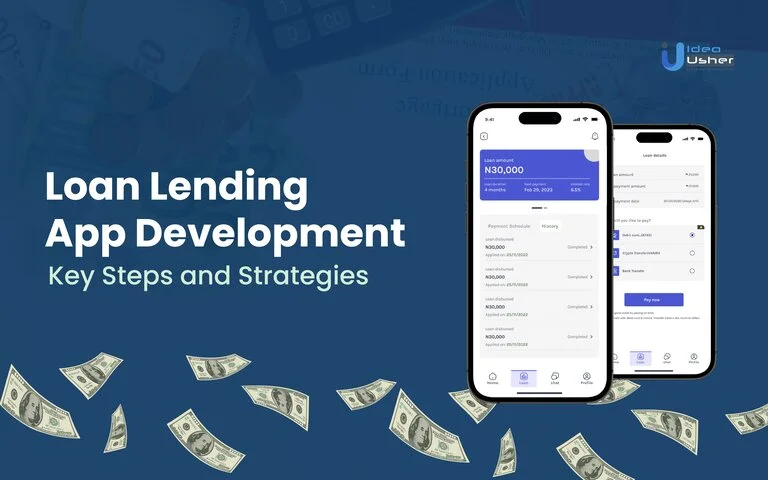Loan lending apps have revolutionized the lending industry, providing quick and convenient access to credit for people who need it. Whether you’re looking to pay off debt, fund a business venture, or cover unexpected expenses, loan lending mobile apps offer many options to suit your needs.
But developing such an app is no small feat. It requires a deep understanding of the lending industry, as well as expertise in app development and user experience design. From market research to compliance with regulatory standards, there are many factors to consider when developing a loan lending app.
In this article, we’ll explore everything you need to know about loan lending mobile app development, including the latest trends in digital lending, must-have features for loan lending mobile applications, the developmental life cycle, and an overview of the cost of developing such an app.
So, without further ado, let’s dive into it.
What is a p2p Loan Lending Mobile App?
P2P loan apps, also known as peer-to-peer lending platforms, are revolutionizing how people access credit. Forget the traditional bank route with its paperwork and wait times. These apps connect borrowers directly with lenders, offering a faster and potentially more flexible financing option.
Think of it as a digital marketplace for loans. Borrowers can post their loan requests, outlining the amount needed and the purpose. Lenders browse these requests and choose to fund based on the borrower’s profile and offered interest rate.
The Perks of P2P Loan Apps:
- Convenience at Your Fingertips: Download the app, create an account, and you’re ready to go. No need to schedule bank appointments or deal with lengthy processes.
- Potential for Faster Funding: Compared to traditional loans, P2P platforms can offer quicker approvals and disbursements.
- Competitive Rates: Borrowers may find lower interest rates than traditional bank loans, while lenders can potentially earn higher returns compared to savings accounts.
Why Are Loan Lending Apps So Popular?
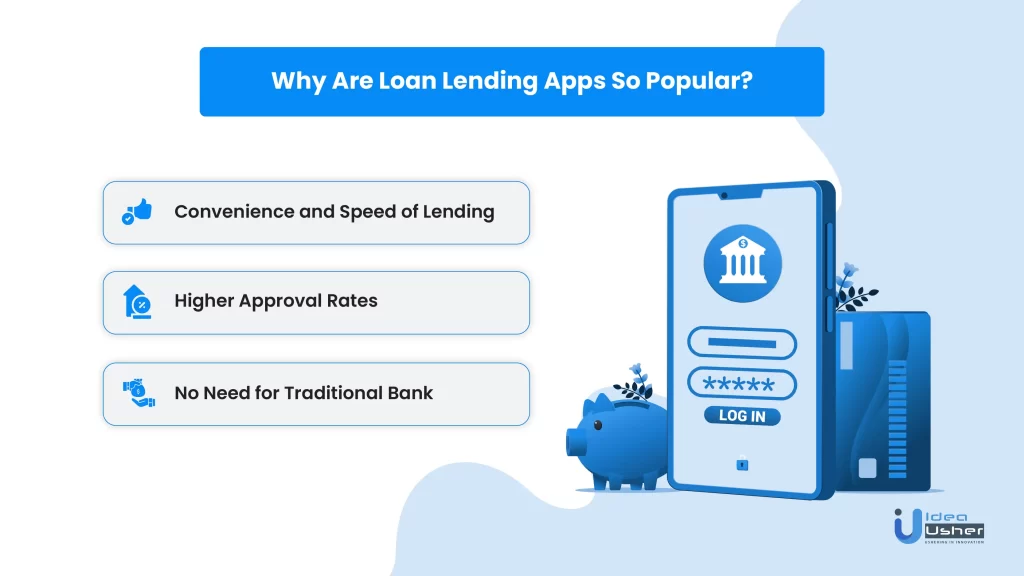
Hassle and inconvenience are the modern-day populace’s worst enemies. Loan lending apps eliminate these barriers and provide people with accelerated lending services. These apps are becoming increasingly popular due to three reasons:
1. Convenience and Speed of Lending Process
Thanks to their user-friendly and efficient lending process, with just a few clicks, borrowers can access funds quickly and conveniently without needing a time-consuming visit to a traditional bank. This convenience is particularly attractive to borrowers who have busy schedules and prefer to manage their finances digitally.
2. Higher Approval Rates
They offer high approval rates, providing borrowers with a greater chance of securing funding, even if they have less-than-perfect credit scores. These apps leverage advanced algorithms and data analysis to assess borrowers’ creditworthiness, allowing them to make faster, more accurate lending decisions.
3. No Need for Traditional Bank Loans
Last but not least, lending apps eliminate the need for traditional bank loans, which can be challenging to obtain for some individuals. With these apps, borrowers can access a wider range of lending options, allowing them to choose the loan that best suits their needs and financial situation. As such, it’s no surprise that loan lending apps have emerged as a popular alternative to traditional lending institutions.
Build Better Solutions With Idea Usher
Professionals
Projects
Additional benefits:
Easy Access to Credits: Unlike traditional banks, loan apps have a streamlined process that allows borrowers to apply and receive funds quickly. This is particularly beneficial for those with urgent financial needs or unexpected expenses.
Lower Interest Rates: Compared to traditional lenders, lending app interest rates are usually much lower. This is because they have lower overhead costs and can pass on the savings to their customers. Lower interest rates translate to lower monthly payments, making it easier for borrowers to manage their finances.
Flexible Repayment Options: These apps allow borrowers to select a repayment plan that suits their preferences and budget. This flexibility allows borrowers to customize their loan experience and make it work for their unique financial situation.
How Do Loan Lending Mobile Apps Work?
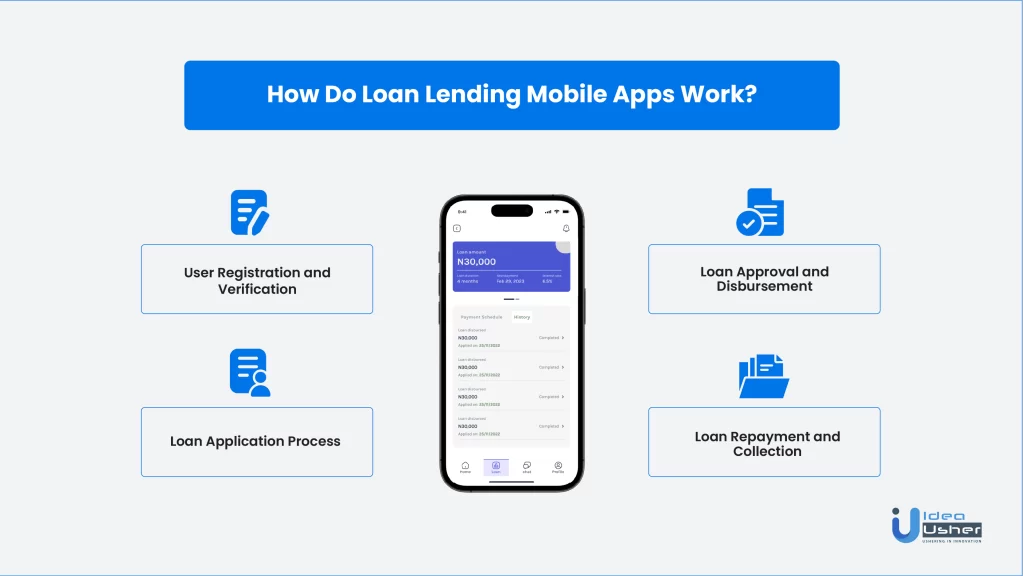
The functionality of a loan lending app typically consists of four main components.
User Registration and Verification
The process begins with users downloading and installing the app on their mobile devices. Upon registration, users provide their personal information, such as name, contact details, and identification documents, which the app verifies through ID checks and facial recognition technology. The app also checks the user’s credit history and score to determine loan eligibility.
Loan Application Process
When users apply for a loan, they enter the loan amount, duration, and purpose, and the app uses machine learning algorithms to assess their creditworthiness. The app generates a loan offer with interest rates and repayment terms, which users can accept or reject. If the user accepts the offer, they sign the loan agreement electronically within the app.
Loan Approval and Disbursement
For the next step, the application undergoes a final review by the app’s underwriting team. Once approved, the app disburses the loan amount directly to the user’s bank account or mobile wallet. The user receives a notification in the app confirming loan disbursement.
Loan Repayment and Collection
Repayment and due collection can also be programmed within the app. The app sends reminders to the user via push notifications, SMS, or email, and the user can make repayments within the app using a linked bank account or mobile wallet. The app automatically deducts the loan repayment amount on the due date. In case of late or missed payments, the app initiates collection actions such as penalty fees and credit score reporting.
Build Better Solutions With Idea Usher
Professionals
Projects
Market Potential of Loan Lending Mobile Apps
- The global digital lending platform market is projected to experience a CAGR of 18.4%, growing from $8.91 billion in 2021 to $10.55 billion in 2022. By 2026, the market is expected to reach $20.34 billion, exhibiting a CAGR of 17.8%.
- Key digital lending platform markets include decision automation, loan origination, recovery and collections, compliance and risk management, and others.
- North America became the largest growing region within the digital lending platform market in 2021, with Asia Pacific predicted to be the fastest-growing region in the forecast period.
- The use of smartphones is expected to drive the growth of the digital lending platform market as borrowers apply for instant loans using digital lending.
- Technological advancements, such as automation across business processes, are a key trend in the digital lending platform market.
- Examples of recent technological advancements within the space include Roostify Inc.’s AI-powered Application Programming Interface and M2P Fintech’s acquisition of Finflux for workflow automation.
- Other major countries with subsequent market capitalization prospects include Australia, Brazil, China, France, Germany, India, Indonesia, Japan, Russia, South Korea, the UK, and the USA.
- Prime industry verticals that partake in this space include banks, insurance companies, credit unions, savings and loan associations, peer-to-peer lending, and others.
Top 10 Types of Loan Lending Application Development Categories
The key to success in loan lending app development lies in understanding your target audience. Here’s a breakdown of popular loan categories, with a focus on features that add value for both borrowers and lenders:
1. Student Loans:
- Targeted Features: Partner with universities for seamless loan application integration within financial aid portals. Integrate scholarship and grant tracking to optimize loan amounts. Consider income-driven repayment options for flexibility.
- Value Proposition: Streamline student loan applications, reduce paperwork, and offer competitive rates tailored to educational needs.
2. Home Loans:
- Targeted Features: Incorporate property search and valuation tools directly into the app. Integrate with real estate agents and closing services for a one-stop shop experience. Offer pre-qualification options to empower informed decisions.
- Value Proposition: Simplify the complex home buying process with streamlined applications, on-the-go property insights, and transparent communication.
3. Vehicle Loans:
- Targeted Features: Integrate with used car marketplaces and dealerships for instant loan estimates. Offer AI-powered car valuation tools to determine fair market value. Provide secure payment gateways for car down payments.
- Value Proposition: Streamline the car buying process with instant loan approvals, transparent pricing, and secure payment options for a stress-free car purchase journey.
4. Personal Loans:
- Targeted Features: Develop budgeting and financial planning tools within the app to promote responsible borrowing. Offer personalized loan recommendations based on creditworthiness and financial goals. Integrate AI-powered chatbots for 24/7 loan application support.
- Value Proposition: Foster responsible borrowing through financial literacy tools. Provide personalized loan options with transparent terms and readily available customer support.
5. Business Loans:
- Targeted Features: Implement AI-powered credit scoring models tailored to small businesses. Integrate with accounting platforms for streamlined loan application processes. Offer business mentorship programs and educational resources.
- Value Proposition: Expedite loan approvals for small businesses with innovative credit assessment tools. Bridge the gap between financing and growth through expert resources and mentorship programs.
6. Line of Credit Loans:
- Targeted Features: Develop a user-friendly interface for managing credit lines and repayments. Integrate budgeting tools to track credit utilization. Offer automatic payments to avoid late fees.
- Value Proposition: Provide borrowers with flexible access to funds and empower responsible management with budgeting tools and automated payments.
7. Medical Expense Loans:
- Targeted Features: Partner with healthcare providers to offer pre-approved loan options for specific procedures. Integrate with insurance companies for streamlined claim processing.
- Value Proposition: Ease the financial burden of medical emergencies with readily available financing and simplified claim processing.
8. Green Loans:
- Targeted Features: Partner with eco-friendly vendors to offer financing for energy-efficient home improvements or electric vehicles. Integrate tools to estimate energy savings and environmental impact.
- Value Proposition: Encourage environmental responsibility by providing financing for sustainable solutions and quantifying the positive impact.
9. Debt Consolidation Loans:
- Targeted Features: Integrate with external accounts to simplify the debt consolidation process. Offer tools to track progress toward debt elimination. Provide educational resources on responsible debt management.
- Value Proposition: Streamline debt management, simplify repayments, and empower borrowers with tools and resources to achieve financial wellness.
10. Payday Advance Loans:
- Targeted Features: Develop a secure and responsible loan application process with clear terms and fees. Implement budgeting tools and financial literacy resources to promote responsible borrowing habits.
- Value Proposition: Provide a safe and transparent alternative for urgent financial needs while encouraging responsible borrowing through educational resources and budgeting tools.
Build Better Solutions With Idea Usher
Professionals
Projects
Latest Trends in Digital Lending
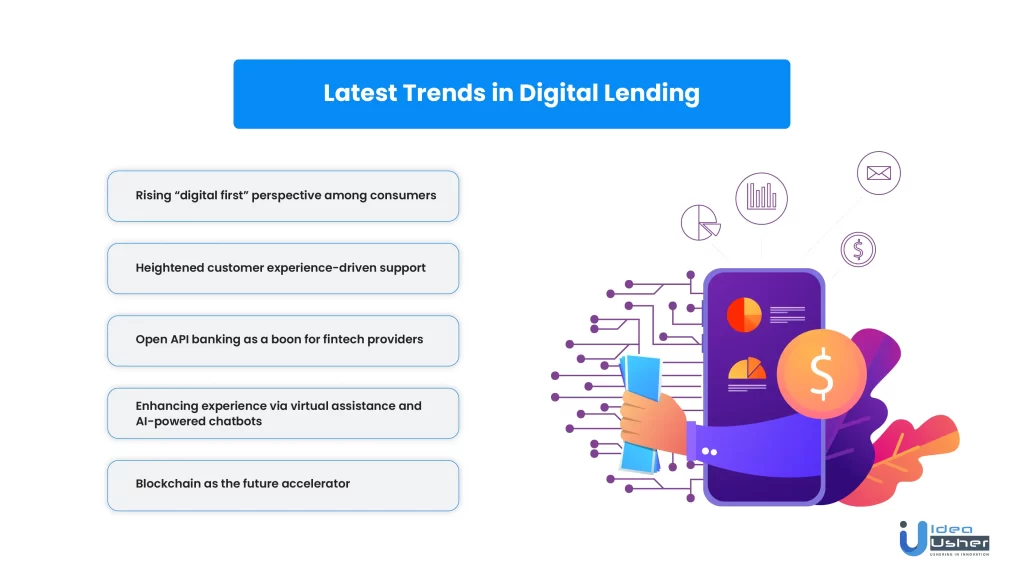
Digital lending will continue to shape the future of the banking industry, and many banks will morph into pure technology companies that offer digital solutions by leveraging their extensive customer base and large distribution channels.
The following digital banking technology trends are expected to shape the future of digital lending in 2023:
Rising “digital first” perspective among consumers
An increasing number of consumers are prioritizing digital channels over traditional contact methods. This trend is not only fueled by the desire to view available products but also by a preference for the convenience of online and mobile banking. As digital solutions evolve, many financial providers will likely scale back their physical branch networks in favor of digital alternatives. This shift towards “digital maturity” is expected to gain momentum in the coming years, making it a vital consideration for lenders looking to remain competitive.
Heightened customer experience-driven support
Providing a superior customer experience quickly becomes the key differentiator for loan and other financial services providers. By prioritizing customer experience in their digital transformation, emerging establishments/businesses can ensure their solutions meet customer needs for convenience, security, comfort, and engagement. In fact, personalized offers that consider customer feedback and preferences are increasingly expected.
To stay competitive, anticipating customer needs and enhancing their experiences will set establishments apart from their rivals. Advanced analytics applied to customer experience can help improve service quality while reducing costs. In the near future, such will enable banks to understand their customers better, allowing them to not only customize offers but also anticipate needs and provide even higher service levels.
Open API banking as a boon for fintech providers
Open API banking is transforming the financial space by allowing banks to share data with fintech providers, making transactions faster and more secure. Despite security challenges, open APIs will continue to be the preferred choice for banks and third-party providers in 2023, with closer collaboration between financial institutions and developers expected to drive innovation and improve customer experiences. To stay competitive, digital lenders should leverage open APIs to offer improved services and experiences to their customers.
Enhancing experience via virtual assistance and AI-powered chatbots
Digital lenders are increasingly turning to AI-powered chatbots and virtual assistants to enhance customer experience. By 2025, natural language processing will be the norm for customer interaction, with chatbots and virtual assistants becoming commonplace in banking apps across most devices, including smartphones and tablets.
These technologies have already impacted banking, with several banks launching chatbots and virtual assistants. For instance, HDFC Bank in India piloted a virtual assistant for its online platform to improve digital experiences for customers. BBVA’s virtual assistant has been particularly popular with the younger demographic in Latin America.
Chatbots and virtual assistants can provide automated answers to frequently asked questions, reduce call center volume, and free up staff time for more valuable tasks. Leveraging chatbots and virtual assistants can help lenders offer a smarter, more personalized banking experience and improve customer satisfaction and loyalty.
Blockchain as the future accelerator
Blockchain technology has great potential for improving operations and the customer experience in financial services. In 2023, we can expect its adoption to extend beyond simple transactions and money transfers. Blockchain-based KYC and customer due diligence will become more prevalent, storing data on decentralized platforms for better verification and security. Securities regulations will enable tokenized assets to be used in traditional financial markets. Blockchain-based transaction processing platforms will be complementary to existing settlement systems. As the use of blockchain-based digital currencies grows, we can expect more regulatory collaboration and standardization efforts to create a framework for their coexistence with traditional forms of money. However, it will take time for blockchain technology to mature fully.
Must-Have Features in Loan Lending Apps
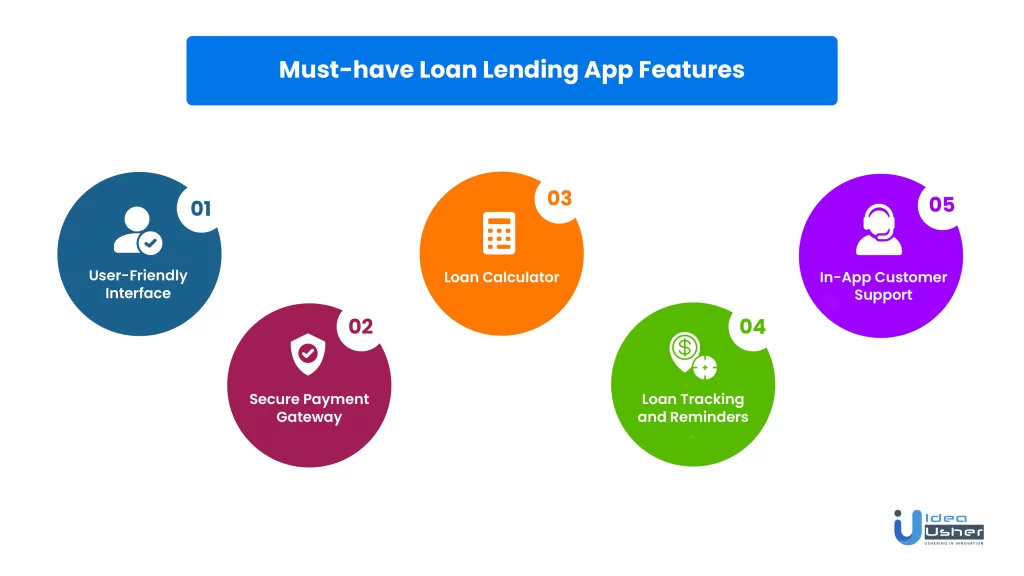
Let’s delve into the must-have functionalities from an app development perspective:
Streamlining the Borrower Journey:
- Effortless Onboarding: Frictionless sign-up is crucial. Utilize social logins or streamlined data entry forms to get users started quickly.
- Loan Comparison Engine: Empower borrowers with choice. Integrate a loan comparison feature that displays options from various lenders with clear interest rates, APRs, and repayment terms.
- Instant Eligibility Checks: Leverage AI-powered credit scoring or integrate with credit bureaus (with user consent) to provide real-time eligibility checks without impacting credit scores. This transparency builds trust and avoids unnecessary application denials.
- Crystal-Clear Loan Terms: Eliminate surprises. Clearly display all loan details upfront, including interest rates, Annual Percentage Rates (APRs), repayment schedules, and any associated fees. Transparency builds trust and avoids user frustration.
- Secure Loan Application: Safety is paramount. Integrate secure logins with multi-factor authentication and robust data encryption to protect user information throughout the application process.
Empowering Lenders with Efficiency:
- Automated Risk Assessment: Speed up decision-making. Implement AI-powered credit scoring models or integrate with credit bureaus to efficiently assess borrower creditworthiness and risk profiles.
- Simplified Loan Approval Workflow: Reduce manual tasks. Automate workflows with e-signatures and document management features to expedite loan approvals and minimize processing times.
- Secure Payment Processing: Reliability is key. Integrate secure payment gateways with features like fraud detection to ensure safe and reliable loan repayments.
- Investor Dashboard: Provide lenders with a comprehensive control center. Develop a user-friendly dashboard that allows lenders to track loan portfolios, manage investments, and monitor borrower activity. Real-time data insights empower informed decision-making.
- Integrated Communication Tools: Facilitate seamless interaction. Integrate secure communication channels within the app for lenders to connect directly with borrowers. This fosters transparency and streamlines the loan management process.
Beyond the Basics: Building a Robust Ecosystem
- Financial Literacy Tools: Promote responsible borrowing. Integrate budgeting tools, financial calculators, and educational resources within the app. This empowers users to make informed financial decisions and builds trust in your platform.
- Personalized Features: Go beyond generic experiences. Consider features like customized loan recommendations based on user profiles and financial goals. This level of personalization enhances user experience and satisfaction.
- Push Notifications: Stay connected with your users. Send timely reminders for upcoming loan repayments, application updates, and special offers. However, avoid bombarding users with irrelevant notifications to maintain a positive user experience.
- Multilingual Support: Expand your reach. Catering to a wider audience by offering the app in multiple languages can significantly increase your user base, especially if you target international markets.
Building Trust Through Security and Transparency
By prioritizing robust data security measures and transparent communication throughout the loan application and repayment process, you can build trust with both borrowers and lenders. Remember, a user-friendly interface and a focus on a positive user experience are key to attracting a loyal user base and driving long-term success for your loan lending app.
Advanced Features to Consider for Loan Lending Apps
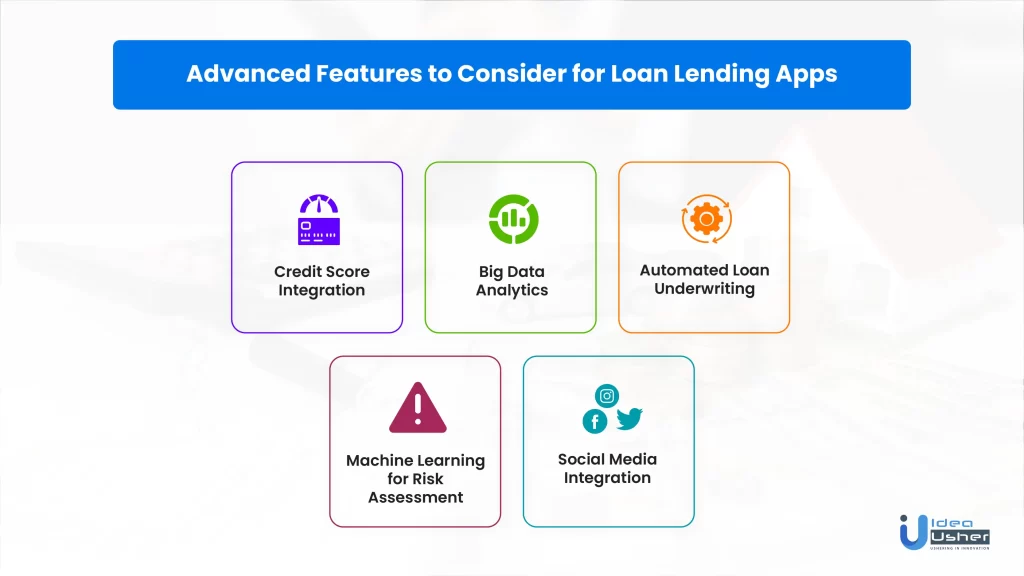
Credit Score Integration
Loan lending apps can integrate with credit bureaus to fetch user credit scores and credit reports. This feature enables lenders to assess borrowers’ creditworthiness accurately. By integrating credit scores into the app, lenders can provide loan offers with personalized interest rates and repayment terms. Users can also monitor their credit scores in real time, which can help them make informed financial decisions.
Big Data Analytics
Big data integration can help loan lending apps analyze large sets of data to identify user behavior patterns and market trends. By leveraging machine learning algorithms, loan lending mobile apps can optimize approval rates and reduce credit risk. Big data analytics can also help lenders to determine loan products that are suitable for specific demographics, such as students or entrepreneurs.
Automated Loan Underwriting
Automated loan underwriting involves using technology to assess loan applications and determine eligibility. Loan lending apps can use algorithms to automatically underwrite loan applications, reducing the time and cost of manual underwriting. Automated underwriting also improves the accuracy and consistency of loan decisions, resulting in higher approval rates and lower credit risk.
Machine Learning for Risk Assessment
Loan lending mobile apps can use machine learning algorithms to analyze user data and assess credit risk accurately. By analyzing user data such as transaction history, credit history, and social media activity, machine learning algorithms can identify risk factors and assess creditworthiness. This feature enables loan lending apps to provide loan offers with personalized interest rates and repayment terms based on the user’s risk profile.
Social Media Integration
You can also integrate your app with social media platforms to access user data, including social media activity, to assess credit risk. By analyzing social media data, the app can identify user behavior patterns and assess creditworthiness. Social media integration also allows lenders to verify user identity and reduce fraud. This feature enables loan lending mobile apps to offer loans to individuals with a limited credit history or no credit score.
Build Better Solutions With Idea Usher
Professionals
Projects
Step-by-Step Guide to Developing a Loan Lending App
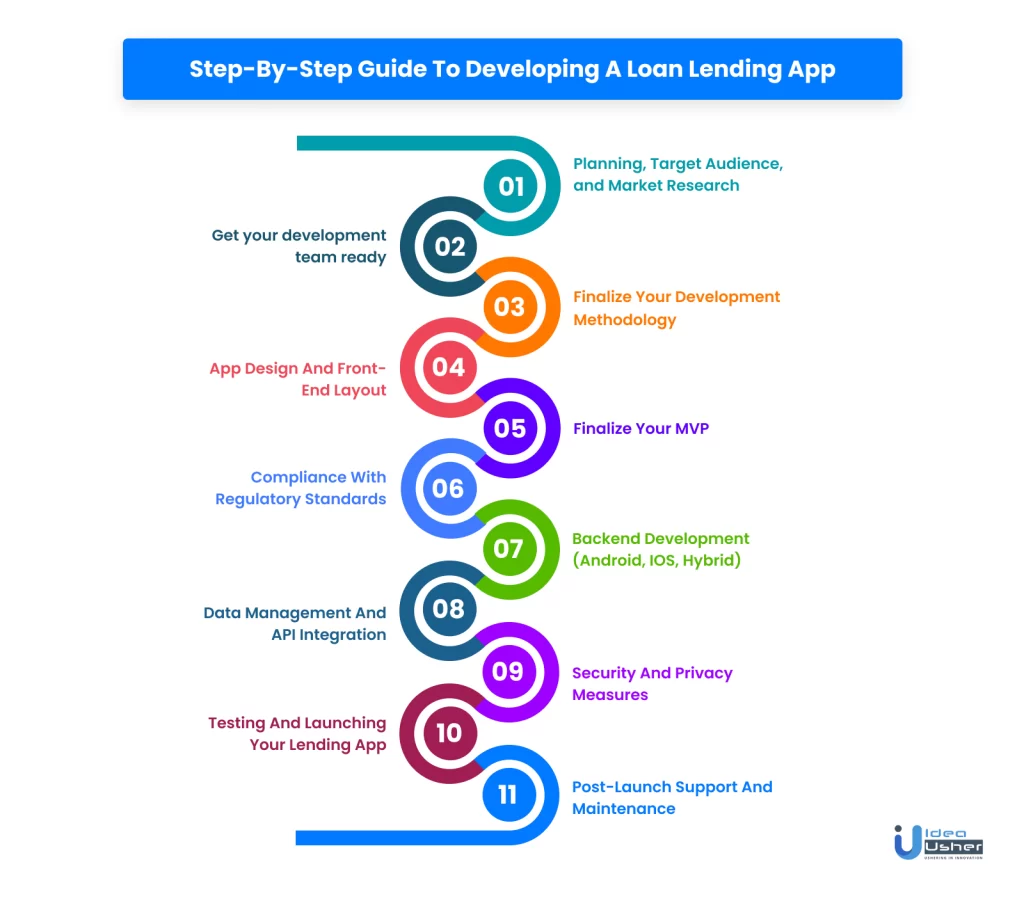
1. Planning, Target Audience, and Market Research
To begin the development lifecycle, it is crucial to plan and gather the app feature requirements. This involves researching the target audience, their needs, and their location and conducting comprehensive market research to identify the gaps in the existing loan lending apps. This data will provide insights into what features to build into the app to meet the user’s requirements.
Analyzing competitors’ offerings and their market responses also helps create a unique value proposition for the app. Development teams need to determine what resources will be required to implement the app’s features successfully, including finance experts, regulatory experts, and other relevant professionals. By taking these steps, the app will be developed with a clear understanding of user needs and market gaps, leading to a competitive advantage.
2. Get your development team ready
To build a successful loan lending mobile app; you will need a team of professionals with a diverse range of skills. This team should include a business analyst who can help identify the target audience and their needs, a UX/UI designer who can create an engaging and user-friendly interface, 1-2 experienced mobile app developers who can build a high-quality and scalable product, an application tester who can ensure the app is bug-free and secure, and a project manager who can oversee the entire development process and ensure timely delivery of the project. Each member of the team plays a critical role in the success of the project, and their expertise must be leveraged to achieve the desired outcome.
3. Finalize your development methodology
Selecting the appropriate mobile app development methodology is a crucial step in your lending app development lifecycle. Agile methodology is commonly utilized for mobile app development projects due to its ability to reduce estimation and development errors. This methodology facilitates quality testing of mobile apps at each development stage.
The Agile development approach is an iterative process where the entire development process is divided into several short iterations. At the end of each iteration, the product is delivered to the customers for feedback. This approach minimizes the risk of a product’s market failure by incorporating customer feedback from the project’s outset.
Your team of developers can opt for Agile frameworks such as Scrum, Kanban, and XP, among others. By embracing Agile methodology, your team can ensure a streamlined development process with efficient error detection and timely feedback incorporation to enhance the success of your app in the market.
4. App Design and Front-end Layout
Once you finalize your methodology, the next step is to decide upon your app’s design and front-end layout. To ensure an intuitive and engaging user interface, consider the target audience and their preferences for colors, fonts, and images that align with the brand’s identity and values.
Optimizing the front-end layout for mobile devices is critical for a seamless user experience. To achieve this, choose responsive tech stacks like React Native or Flutter that adjust to different screen sizes and orientations. Additionally, prioritize accessibility features to ensure your app is user-friendly for people with disabilities.
By focusing on app design and front-end layout and selecting appropriate tech stacks, your lending app can provide a positive user experience, stand out in a competitive market, and attract and retain users.
5. Finalize your MVP
The next step in developing your lending app is to create a Minimum Viable Product (MVP) that focuses on the core features essential for user functionality. Releasing an MVP allows you to gather valuable feedback and ensure your business strategy aligns with the target market while avoiding resource waste.
Building an MVP requires a skilled and experienced team of mobile app developers with expertise in various technologies. A lending app must adhere to strict financial regulations, making it essential to prioritize security and regulatory compliance.
By developing an MVP, you can streamline the development process and gather valuable feedback to improve the user experience while maintaining compliance with financial regulations. This approach saves time, cost, and effort while enhancing the overall effectiveness of your lending app.
6. Compliance with Regulatory Standards
As your app will primarily deal with transactional operations and personal user data; you must comply with the laws and regulations in various regions such as Australia, Eastern Europe, and Western Europe.
These compliance standards include GDPR for the European Union software market and CCPA for software products marketed to California residents. It is important to research and complies with the appropriate standards to avoid penalties and protect personal data.
7. Backend development (Android, iOS, Hybrid)
Now comes the point when you have to develop the backend structure of your app. It’s important to consider the platform you will use.
For Android, developers should use Java, Kotlin, or both to build the app and should know how to use Android Studio and Eclipse to develop and debug it efficiently. Android interactivity components and Material Design Guidelines should also be used to build a stable user interaction process and a UI that aligns with Android UI/UX standards.
For iOS, Swift is the preferred programming language, and developers should have expertise in Swift syntax and design patterns such as MVC. XCode is the primary IDE used to build and debug iOS apps, while Human Design Guidelines can be used to build frontend layouts aligned with Apple products.
Alternatively, hybrid apps can be developed using common web development technologies such as CSS, Html, and JavaScript, then wrapped into native containers to run on different mobile platforms. Cross-platform app development frameworks like Ionic and Xamarin can be used to code efficiently.
8. Data management and API integration
For data processing and management, mobile app developers should use databases like Room database for Android Core Data framework for iOS, and database management systems like MySQL or PostgreSQL.
Lastly, to enhance app functionality, APIs can be used to add multiple features, such as notifications, file system management, and secure payment channels.
Some popular APIs for Android include Cloud Storage, Retrofit, and GSON for managing cloud data, interfacing with external APIs, and handling Java objects, respectively. Android developers can also use Google Pay for payment infrastructure.
For iOS developers, the ObjectMapper API and CloudRail API are useful for communicating with online APIs and managing cloud data. Apple Pay and Apple Push Notification Service are also commonly used for payment channels and notification features.
9. Security and Privacy Measures
Fintech apps usually deal with private customer information. Therefore maintaining the app’s security is of utmost necessity.
Developers should be knowledgeable about common cybersecurity threats like SQL injection and phishing. Implementing two-factor authentication and encryption techniques can protect user accounts and personal data. APIs like Twilio and Plaid can assist with these security measures.
10. Testing and launching your lending app
To ensure your money lending app meets all requirements, conduct extensive testing, including unit, regression, localization, integration, performance, and security testing. Use software tools like Appium, Espresso (for Android), and XCTest (for iOS) to automate testing.
After release, engage users for feedback through feedback forms, app ratings, and NPS. Tools like SurveyMonkey and Promoter.io can help. Use customer data to improve the app and marketing strategy. Data analytics tools like Qualtrics can help identify trends in feedback data.
11. Post-launch support and maintenance
Post-launch maintenance is a critical phase in the lifecycle of any mobile application. It involves maintaining the app’s functionality, fixing bugs, and releasing updates to meet user expectations and preferences.
Your app development team should regularly monitor the app’s performance and user feedback to identify issues that require attention. They can use tools like Firebase, Crashlytics, and New Relic to track and analyze user behavior and app crashes.
Bug fixes, security patches, and updates to support new features are necessary for maintaining the app’s quality and reliability. These updates should be released regularly to ensure the app remains up-to-date with the latest mobile operating system changes and security standards.
Apart from maintenance, you should provide customer support to users facing technical issues with the app. The support team can respond to user queries, troubleshoot problems, and assist in using the app effectively.
Lastly, you should consider continually enhancing the app’s features to keep up with user demands and preferences. This can involve integrating new technologies, improving existing features, and adding new ones.
Cost of Developing a Loan Lending App
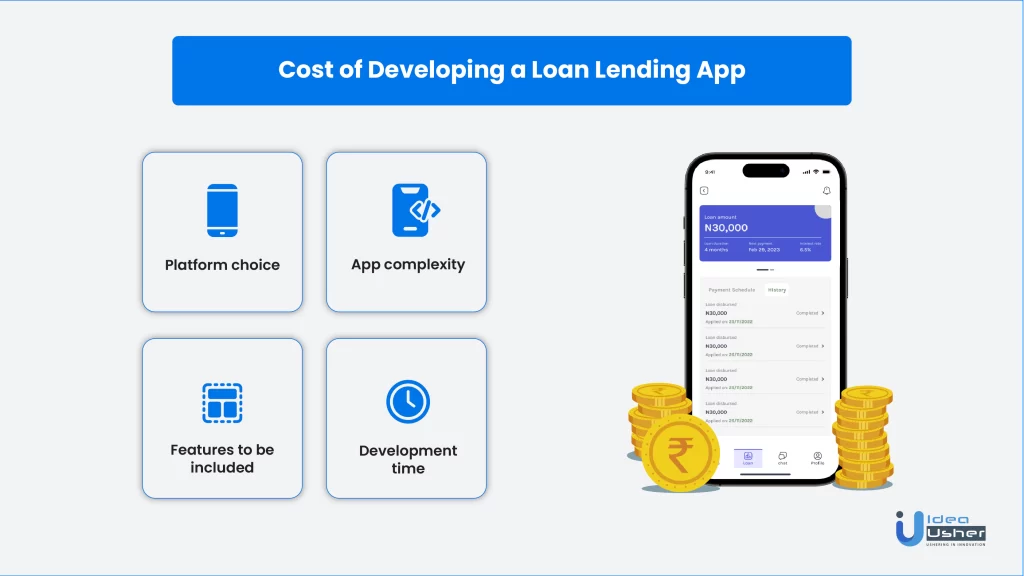
The cost of developing a loan lending mobile app depends on various factors, such as the app’s complexity, platform choice, features to be included, development time, and resources required.
- Platform choice: Your choice of platform for developing the app greatly affects the development cost. Developing a loan lending app for both Android and iOS platforms will cost more than developing it on a single platform.
- App complexity: The app’s complexity also affects the development cost. The more complex the app, the more time and resources are required; thus, the higher the development cost.
- Features to be included: Your preferred features and their extensiveness can also affect the development cost. The more features, the higher the development cost.
- Development time: Last but not least, the time taken for development can imply higher costs. The longer the development time, the higher the development cost.
Cost Breakdown for Different App Features
Here is a breakdown of the cost of developing various app features for a loan lending app:
| App Feature | Estimated Cost (USD) |
| User registration and login | $2,500 – $5,000 |
| Loan application form | $3,000 – $6,000 |
| Loan eligibility calculator | $3,500 – $7,000 |
| Integration with credit bureaus | $4,000 – $8,000 |
| Verification of user identity | $4,500 – $9,000 |
| Integration with payment gateways | $5,000 – $10,000 |
| Loan approval and disbursement process | $6,000 – $12,000 |
| Loan repayment system | $7,000 – $14,000 |
| Customer support system | $3,000 – $6,000 |
| Integration with third-party services | $5,000 – $10,000 |
| Analytics and reporting system | $3,500 – $7,000 |
| Security and data protection | $6,000 – $12,000 |
Note that these costs are only estimates and may vary depending on the complexity of the app and the region in which it is being developed. Additionally, ongoing maintenance and updates will also contribute to the overall cost of the app.
Final Takeaway
As the world becomes more digitally connected, the demand for loan lending apps is only set to increase. With the convenience of applying for loans from the comfort of one’s home, these apps are becoming an integral part of the financial industry.
For app developers and entrepreneurs, it is crucial to keep up with the latest trends and technology to provide users with the best possible experience. Incorporating features like easy onboarding, fast loan processing, and secure payment gateways can go a long way in building customer trust and loyalty.
With years of experience in app development and a team of skilled developers, Idea Usher can help you create a unique and user-friendly loan lending mobile application that meets all your business requirements. If you want to stay ahead of the game, partner with Idea Usher and turn your vision into a reality.
Get in touch with us now!
Build Better Solutions With Idea Usher
Professionals
Projects
Contact Idea Usher at [email protected]
Or reach out at: (+1)732 962 4560, (+91)859 140 7140
FAQs
Q) How do I start a lending app?
Ans) You can start your lending app by following the below steps.
- Define your target audience and target market.
- Research your competition and market demand.
- Choose a monetization model for your app.
- Hire a reliable development team to build your app.
- Test your app extensively and launch it in the Play Store or App Store.
Q) How to create a personal loan app?
Ans) To create your personal loan app, follow the steps below:
- Define the loan types and eligibility criteria.
- Determine the loan amount, interest rate, and repayment terms.
- Develop a user-friendly interface and intuitive user flow.
- Implement a secure payment gateway and data encryption techniques.
- Launch your app in the app store and promote it to reach your target audience.
Q) How much does it cost to develop a loan lending app?
Ans) The cost of developing a loan lending mobile application depends on several factors, like app features, complexity, development team, and geographic location. On average, the cost can range from $50,000 to $500,000.
Q) How do money-lending apps make money?
Ans) Money lending apps make money through interest rates, loan processing fees, late payment penalties, and other miscellaneous fees.
Q) Can Idea Usher build a loan lending app for me?
Ans) Yes, Idea Usher has expertise in developing loan lending apps and can build customized solutions to meet your requirements. Contact us to discuss your project details.
